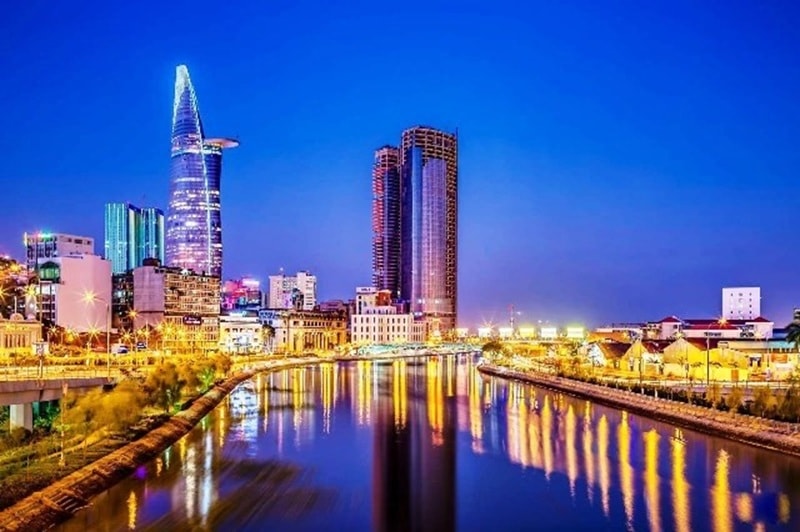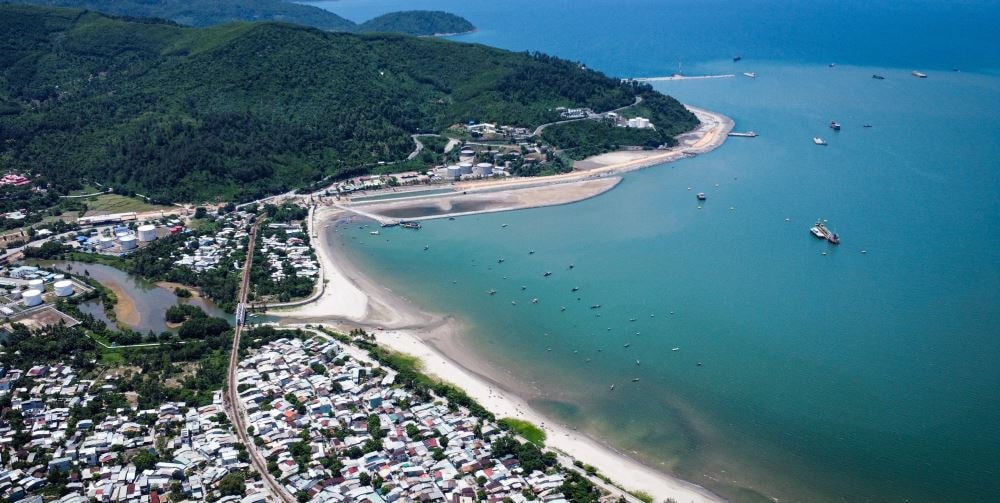International Financial centers: Strategic development axis for HCM City – Da Nang
According to Ms. Nguyễn Minh Hạnh, Director of the Analysis Center at SHS Securities, the draft resolution on establishing an international financial center proposes the model of “one center, two destinations” located in Ho Chi Minh City and Da Nang. Some National Assembly delegates have raised questions about the rationale behind this model.

Ho Chi Minh City (HCMC) can be briefly described as a leading economic engine with numerous advantages, though still facing many bottlenecks to resolve.
Ho Chi Minh City – A Locomotive with Many Advantages
As the largest urban area in Vietnam and one of the most dynamic economic hubs, HCMC possesses many natural conditions to become an international financial center (IFC). It contributes approximately 23% of the national GDP and is home to the headquarters of most commercial banks, securities companies, investment funds, and Vietnam's largest stock exchange – HOSE.
Geographically, HCMC has advantageous access to key trade routes and convenient connections with major Asian financial hubs like Singapore, Hong Kong, and Bangkok. The city also fosters a vibrant financial–corporate ecosystem, where fintech companies, insurers, and multi-sector financial services cluster around the core of banking and capital markets, creating a full-value network for financial activities.
In essence, HCMC functions as Vietnam’s main financial artery – where nearly all capital flows pass through before heading outward. The city boasts a young, well-educated workforce, widespread English proficiency, and multiple leading universities in economics and finance.
Recognizing this, the government has designated HCMC as the location to develop a comprehensive international financial center. The project will be based in the new Thu Thiem Urban Area (Thu Duc City), covering 657 hectares. The core financial zone is planned for a 9.2-hectare riverfront plot opposite District 1 – expected to become Vietnam’s future “Wall Street.” Thu Thiem, located across the Saigon River, is envisioned as the “Pudong” of HCMC.
Besides its strategic location, Thu Thiem is one of the rare urban areas with sufficient land for systematic planning from scratch – a key condition for a modern financial center. With a vision of becoming an integrated city combining finance, technology, international education, and high-quality living, Thu Thiem has the potential to become the financial hub of the CLMV subregion (Cambodia, Laos, Myanmar, Vietnam), and even of Southeast Asia. However, to realize this, HCMC must treat Thu Thiem as a “strategic lever” backed by special mechanisms, synchronized infrastructure, and bold institutional reform – as Shanghai once did with Pudong.
Still, it’s crucial to acknowledge current shortcomings: urban infrastructure and living quality in HCMC remain major downsides in the eyes of international investors. Inner-city traffic is frequently congested, and Tan Son Nhat Airport has long exceeded capacity. Long Thanh Airport – expected to be a new key transport hub – won't complete its first phase until 2026.
Healthcare and international education are improving but still fall short of regional standards. The lack of dedicated international financial space (e.g., specialized financial districts, conference centers, international-grade offices) also hampers HCMC’s ability to attract top-tier talent. Tech infrastructure – particularly 5G networks and large-scale data centers – remains below international benchmarks.
In terms of market depth, Vietnam’s capital market is still relatively small and lacks diversity in financial products. Corporate bond issuance amounts to only around 10% of GDP, mostly in government bonds. Derivatives and other financial instruments are almost absent. Market liquidity is weak and dominated by domestic retail investors, resulting in volatility and limited appeal to global institutional players. Additionally, the supply of high-quality professionals in finance, law, and tech remains a key challenge. While HCMC has abundant and promising human resources, developing a world-class financial center requires attracting experienced foreign experts. This, in turn, necessitates improvements in work–life conditions: from visa facilitation and international schools to quality healthcare – secondary but critical factors for talent retention.
Legally, the city still operates under a unified national legal framework without a distinct regime for finance. Yet, a world-class IFC requires a flexible legal environment to experiment with new models and products – hence the urgent need for a regulatory sandbox. HCMC holds a bold vision – but visions alone are insufficient. Success requires synchronized investment, genuine reform, and unwavering strategic focus. HCMC has laid a solid foundation, but what’s needed now is a detailed blueprint and relentless execution. Only with a true "breakthrough spirit" – not symbolic, not rhetorical – can the city evolve from a domestic economic hub to a regional financial center.
Da Nang – A Strategic Extension Arm
While Da Nang lacks the economic scale of HCMC, it holds a strategic position in central Vietnam, acting as a gateway to the East Sea and a transit point between the country’s north and south. This location gives it potential to become a hub for goods, capital flows, and financial services from inland to ocean.
Notably, Da Nang has extensive coastal land – increasingly rare in modern urban planning. The city is developing a land reclamation proposal in Da Nang Bay covering about 1,500 hectares, aiming to create 48 km of new shoreline and a multifunctional urban area incorporating an IFC and free trade zone. This vision resembles iconic developments like Marina Bay Sands or Palm Island – but in a Vietnamese form, where international financial institutions, investment offices, luxury resorts, and high-end services coexist in one integrated space.

Functionally, Da Nang is not meant to duplicate HCMC but to complement it. While HCMC focuses on capital markets, international banking, and traditional financial services, Da Nang is positioned as the cradle for emerging sectors: green finance, fintech, AI, specialized investment funds, and digital financial services. As a "regulatory lab," Da Nang could pilot innovative financial models – from derivatives to infrastructure/energy financing and even digital assets and blockchain – within a tightly managed legal sandbox.
This approach avoids overlapping with HCMC’s existing strengths and creates a unique identity attractive to fintech startups, venture capital, and investors seeking flexible testing grounds. The designated zone is in Son Tra District, spanning 6.17 hectares along coastal roads near the airport and international seaport.
Another notable advantage is Da Nang’s quality of life. Known as “the most livable city” in Vietnam, Da Nang offers blue beaches, lush mountains, growing smart city infrastructure, and leading tourism services – qualities that HCMC and Hanoi struggle to match. For many global professionals, the ideal workplace must pair with pleasant living conditions, and this gives Da Nang a unique edge in attracting talent. With affordable living, appealing scenery, and growing career opportunities, the city is well positioned to attract young experts and fintech firms willing to “put eggs in a new basket” if they see promise. The local government is also actively proposing special incentives for high-quality personnel – from income tax reductions to housing and education support – to build a sustainable elite community.
However, limitations remain. Da Nang’s current economic scale is small (GRDP around $5 billion – less than 1/5 of HCMC), with no capital market and no stock exchange. Building an IFC here requires a different path – not relying on a pre-existing domestic market, but crafting a compelling model that draws external capital and institutions. That’s a difficult challenge, needing breakthrough mechanisms. Otherwise, all the advantages risk staying on paper. Especially, the 1,500-hectare land reclamation project in Da Nang Bay, while promising, demands tens of billions of dollars in investment, long timelines, and regulatory clarity to proceed on schedule.
Running a specialized financial model – like a free-trade finance hub – is unprecedented in Da Nang, so strong technical support from the central government and international advisors is essential. From an investor’s perspective, Da Nang will only become attractive if it offers clear value-added benefits – such as a genuine free trade zone (with exemptions on import and corporate taxes), a dedicated financial court for transparent dispute resolution, and sandbox policies for blockchain and crypto. Without these, investors might simply choose to set up offices in Singapore, HCMC, or connect remotely – rather than establishing a physical presence in Da Nang.








